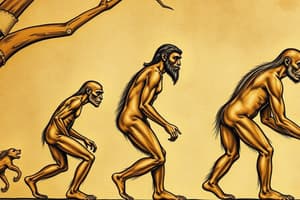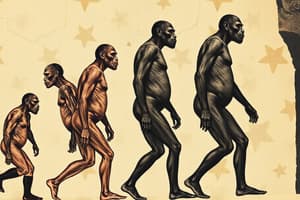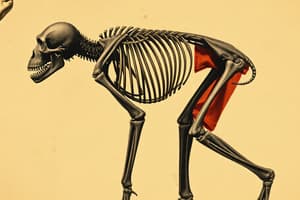Podcast
Questions and Answers
How did the development of lithic technology impact human anatomy?
How did the development of lithic technology impact human anatomy?
- It made stone tools unnecessary for survival.
- It resulted in the reduction of large canines. (correct)
- It led to the growth of larger incisors.
- It caused the complete loss of all teeth.
What is primarily highlighted by the concept of dual inheritance theory?
What is primarily highlighted by the concept of dual inheritance theory?
- Adaptation is solely a biological process without external influences.
- Inheritance of traits is exclusive to genetics.
- Humans inherit traits through both genetics and social learning. (correct)
- Adaptive traits are inherited only through social learning.
Why have humans been particularly successful as a species?
Why have humans been particularly successful as a species?
- Because of their ability to adapt through both biological and technological means. (correct)
- Through the abandonment of any reliance on technology.
- Due to their exclusive reliance on biological evolution.
- Wholly by virtue of their physical strength.
What role does social learning play in human evolution?
What role does social learning play in human evolution?
Before the development of stone tools, what did early humans primarily rely on?
Before the development of stone tools, what did early humans primarily rely on?
What is the significance of the holotype fossil for Homo habilis?
What is the significance of the holotype fossil for Homo habilis?
What time period do the East African fossils of Homo habilis date back to?
What time period do the East African fossils of Homo habilis date back to?
Which location is NOT mentioned as a site where Homo habilis fossils have been discovered?
Which location is NOT mentioned as a site where Homo habilis fossils have been discovered?
Why was the assignment of Homo habilis to the genus Homo controversial?
Why was the assignment of Homo habilis to the genus Homo controversial?
What does the genus Homo encompass?
What does the genus Homo encompass?
What is the estimated height of Homo habilis?
What is the estimated height of Homo habilis?
From which genus do researchers generally believe Homo emerged?
From which genus do researchers generally believe Homo emerged?
What type of evidence is primarily used to assign a specimen to a new species?
What type of evidence is primarily used to assign a specimen to a new species?
What does the name Homo habilis mean?
What does the name Homo habilis mean?
Which evidence suggests that Australopithecines were the earliest stone tool makers?
Which evidence suggests that Australopithecines were the earliest stone tool makers?
What term do archaeologists use specifically for stone tools?
What term do archaeologists use specifically for stone tools?
Why do stone tools persist through time unlike organic materials?
Why do stone tools persist through time unlike organic materials?
What type of stone is most suitable for making effective tools?
What type of stone is most suitable for making effective tools?
What does lithic technology encompass?
What does lithic technology encompass?
What is a significant disadvantage of wood as a tool-making material compared to stone?
What is a significant disadvantage of wood as a tool-making material compared to stone?
What are some of the uses of stone tools mentioned in the content?
What are some of the uses of stone tools mentioned in the content?
What trait distinguishes Homo habilis from Australopithecines?
What trait distinguishes Homo habilis from Australopithecines?
What is the cranial capacity range of Homo habilis?
What is the cranial capacity range of Homo habilis?
How did the molar size of Homo habilis compare to that of Paranthropus?
How did the molar size of Homo habilis compare to that of Paranthropus?
What feature of the dental arcade is notable in Homo habilis?
What feature of the dental arcade is notable in Homo habilis?
Which Homo species is considered transitional to Homo habilis?
Which Homo species is considered transitional to Homo habilis?
What effect does the reduced molar size in Homo habilis have on facial structure?
What effect does the reduced molar size in Homo habilis have on facial structure?
What trend can be observed in the evolution of tooth and jaw size leading up to Homo habilis?
What trend can be observed in the evolution of tooth and jaw size leading up to Homo habilis?
What does the term 'encephalisation' refer to in the context of Homo habilis?
What does the term 'encephalisation' refer to in the context of Homo habilis?
Which property must a stone have to create sharp flakes effectively?
Which property must a stone have to create sharp flakes effectively?
Which type of stone is best known for producing sharp flakes suitable for tool making?
Which type of stone is best known for producing sharp flakes suitable for tool making?
What is the earliest form of stone tool technology called?
What is the earliest form of stone tool technology called?
What was one of the primary uses of the flakes created by early hominins?
What was one of the primary uses of the flakes created by early hominins?
Why do granites not produce sharp flakes despite being a hard stone?
Why do granites not produce sharp flakes despite being a hard stone?
What allowed hominins to evolve differently from other organisms?
What allowed hominins to evolve differently from other organisms?
What was a significant characteristic of the tools used by Australopithecines?
What was a significant characteristic of the tools used by Australopithecines?
What does the term 'lithic technology' refer to?
What does the term 'lithic technology' refer to?
What feature of Homo habilis's hands indicates a more advanced precision grip?
What feature of Homo habilis's hands indicates a more advanced precision grip?
How does the apical tuft of Homo habilis compare to that of chimpanzees?
How does the apical tuft of Homo habilis compare to that of chimpanzees?
What anatomical feature of Homo habilis is associated with efficient bipedal locomotion?
What anatomical feature of Homo habilis is associated with efficient bipedal locomotion?
Which characteristic of Homo habilis's feet indicates a more modern adaptation for walking?
Which characteristic of Homo habilis's feet indicates a more modern adaptation for walking?
What aspect of Homo habilis's manual dexterity distinguishes it from other hominins?
What aspect of Homo habilis's manual dexterity distinguishes it from other hominins?
What historical behavior is correlated with the manual dexterity of Homo habilis?
What historical behavior is correlated with the manual dexterity of Homo habilis?
What is a key anatomical difference between the Australopithecines and Homo habilis regarding foot structure?
What is a key anatomical difference between the Australopithecines and Homo habilis regarding foot structure?
What function does the complex arch system in the foot of Homo habilis serve?
What function does the complex arch system in the foot of Homo habilis serve?
Flashcards
Genus Homo
Genus Homo
The genus to which modern humans belong. It encompasses hominin species considered part of our direct ancestral line.
Homo habilis
Homo habilis
One of the earliest known species in the genus Homo. Most fossils are found in East Africa.
Holotype fossil
Holotype fossil
The very first fossil discovered for a new species. It becomes the standard for identifying that species.
Australopithecus afarensis
Australopithecus afarensis
Signup and view all the flashcards
Overlapping lineages
Overlapping lineages
Signup and view all the flashcards
Fossil evidence for Homo habilis
Fossil evidence for Homo habilis
Signup and view all the flashcards
Homo habilis size and body
Homo habilis size and body
Signup and view all the flashcards
Controversial classification of Homo habilis
Controversial classification of Homo habilis
Signup and view all the flashcards
Homo habilis Brain Size
Homo habilis Brain Size
Signup and view all the flashcards
Homo habilis Encephalization
Homo habilis Encephalization
Signup and view all the flashcards
Homo habilis Molar Size
Homo habilis Molar Size
Signup and view all the flashcards
Parabolic Dental Arcade
Parabolic Dental Arcade
Signup and view all the flashcards
Homo habilis Facial Flattening
Homo habilis Facial Flattening
Signup and view all the flashcards
Megadontia in Paranthropines
Megadontia in Paranthropines
Signup and view all the flashcards
Australopithecus afarensis Teeth
Australopithecus afarensis Teeth
Signup and view all the flashcards
Homo habilis as Transitional Species
Homo habilis as Transitional Species
Signup and view all the flashcards
Precision Grip
Precision Grip
Signup and view all the flashcards
Apical Tufts
Apical Tufts
Signup and view all the flashcards
Homo habilis Hands
Homo habilis Hands
Signup and view all the flashcards
Homo habilis Foot
Homo habilis Foot
Signup and view all the flashcards
Double Arch
Double Arch
Signup and view all the flashcards
Abducted Big Toe
Abducted Big Toe
Signup and view all the flashcards
Homo habilis and Bipedalism
Homo habilis and Bipedalism
Signup and view all the flashcards
Evolution of Foot Structure
Evolution of Foot Structure
Signup and view all the flashcards
What does 'Homo habilis' mean?
What does 'Homo habilis' mean?
Signup and view all the flashcards
Why was 'Homo habilis' initially thought to be the first toolmaker?
Why was 'Homo habilis' initially thought to be the first toolmaker?
Signup and view all the flashcards
Is 'Homo habilis' actually the first toolmaker?
Is 'Homo habilis' actually the first toolmaker?
Signup and view all the flashcards
Who might have been the first toolmakers?
Who might have been the first toolmakers?
Signup and view all the flashcards
What is 'lithic technology'?
What is 'lithic technology'?
Signup and view all the flashcards
Why is 'lithic technology' so important to archaeology?
Why is 'lithic technology' so important to archaeology?
Signup and view all the flashcards
Why are stone tools so useful?
Why are stone tools so useful?
Signup and view all the flashcards
What makes some stones better for tools than others?
What makes some stones better for tools than others?
Signup and view all the flashcards
What are the properties of good flaking stones?
What are the properties of good flaking stones?
Signup and view all the flashcards
What is Mode 1 technology?
What is Mode 1 technology?
Signup and view all the flashcards
What is a hammerstone?
What is a hammerstone?
Signup and view all the flashcards
What are flakes used for?
What are flakes used for?
Signup and view all the flashcards
What is a nodule?
What is a nodule?
Signup and view all the flashcards
Why is a homogenous stone important for flaking?
Why is a homogenous stone important for flaking?
Signup and view all the flashcards
What is biocultural evolution?
What is biocultural evolution?
Signup and view all the flashcards
What is the significance of toolmaking for hominin evolution?
What is the significance of toolmaking for hominin evolution?
Signup and view all the flashcards
Dual Inheritance Theory
Dual Inheritance Theory
Signup and view all the flashcards
Lithic Technology
Lithic Technology
Signup and view all the flashcards
Evolutionary Adaptation
Evolutionary Adaptation
Signup and view all the flashcards
Adaptive Traits
Adaptive Traits
Signup and view all the flashcards
Social Learning
Social Learning
Signup and view all the flashcards
Study Notes
Lecture 6: The Emergence of the Genus Homo
- Genus Homo: Modern humans belong to this genus, encompassing species within our direct lineage.
- Homo habilis: One of the two early species often assigned to the genus Homo.
- Homo rudolfensis: Another early Homo species, currently not the focus of discussion.
- Fossil Evidence: Key fossils often come from East Africa (e.g., Kubifora, Olduvai Gorge).
- Time Period: Homo habilis fossils date from 2.8 million to 1.5 million years ago, overlapping with Australopithecus africanus and Paranthropines.
- Holotype Fossil: The first fossil used to define a new species (e.g., Homo habilis's fossil #7 from Olduvai Gorge).
- Controversial Classification: Assigning fossils to Homo habilis was debated in the 1970s, with some arguing that these specimens were not different enough from other primate species.
- Physical Characteristics: Homo habilis was small-bodied (130cm tall, ~35-45 kg) and had relatively smaller molars than Australopithecines and Paranthropines
- Sexual Dimorphism: Less pronounced sexual dimorphism in Homo habilis fossils than in Australopithecines or Paranthropines.
- Brain Size: Homo habilis had a brain that was significantly larger relative to its body size compared to previous primate species.
Homo's Fossil Evidence and Characteristics
- Fossil 1813: A complete cranium from northern Kenya (1.9 million years ago), with a brain capacity within the range of Paranthropus.
- Fossil 24: A fossil from Olduvai Gorge (1.8 million years ago), with a relatively larger cranial capacity than Paranthropus.
- Fossil 1470: A fairly complete cranium discovered in 1972 with a large brain capacity (775 cubic cm).
- Other Fossils: Other fragments from the Hadar region show teeth comparable to modern humans, as opposed to Australopithecines or Paranthropines in structure.
- Intermembral Index: Homo habilis exhibits an index between 80 and 70, showing trend towards longer legs compared to arms.
- Feet: Homo habilis fossils reveal a foot structure similar to modern humans, with an enlarged big toe and a double arch for bipedal walking.
Homo habilis and Stone Tools and Technology
- Homo habilis's Name: Derived from the name, "handyman," to reflect initial thinking that this species was likely the first toolmakers.
- Old Stone Tools: Evidence exists of stone tools predating Homo habilis (e.g., 3.4 million years old tools from Hadar).
- Lithic Technology: This refers to stone tools and their manufacturing techniques.
- Mode 1 Technology: The simplest form of stone tool technology, used by Australopithecines, Paranthropines, and early Homo species.
- Stone tool use: Stone tools were used for tasks like butchering animals, woodworking, making clothing and digging sticks.
Studying That Suits You
Use AI to generate personalized quizzes and flashcards to suit your learning preferences.




